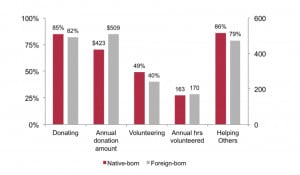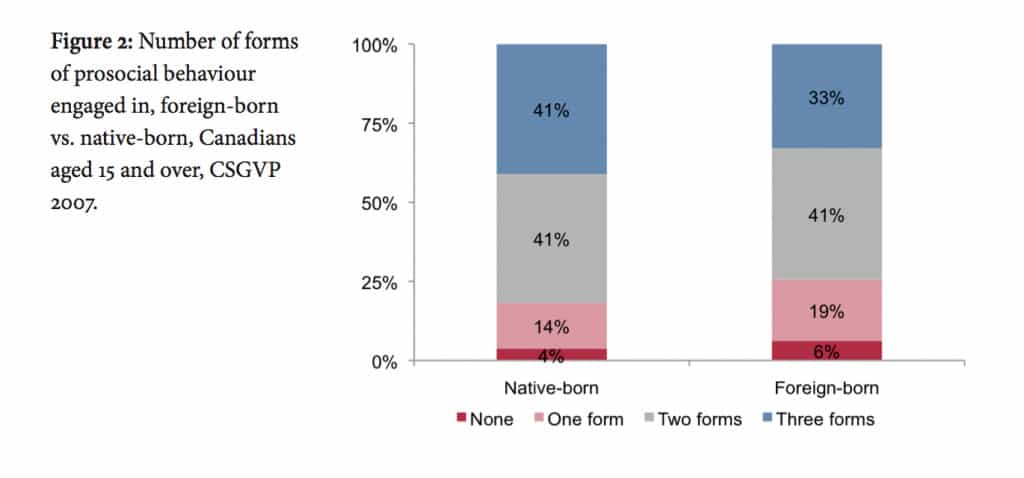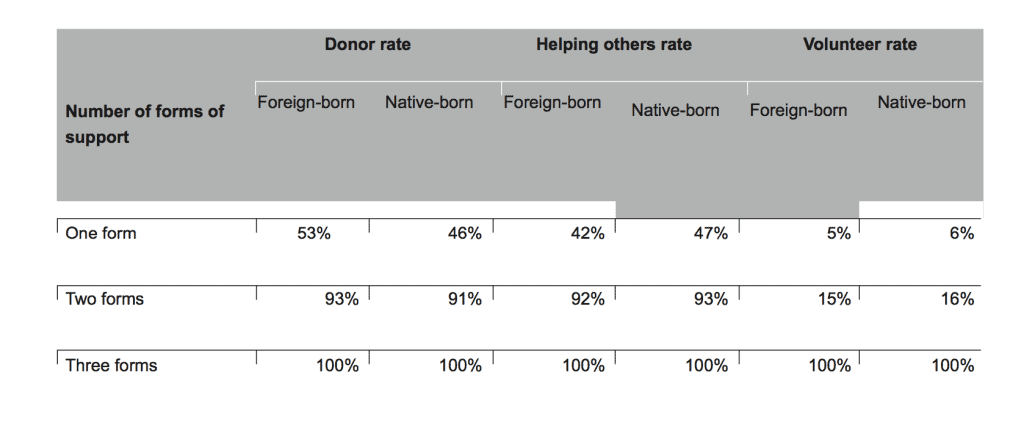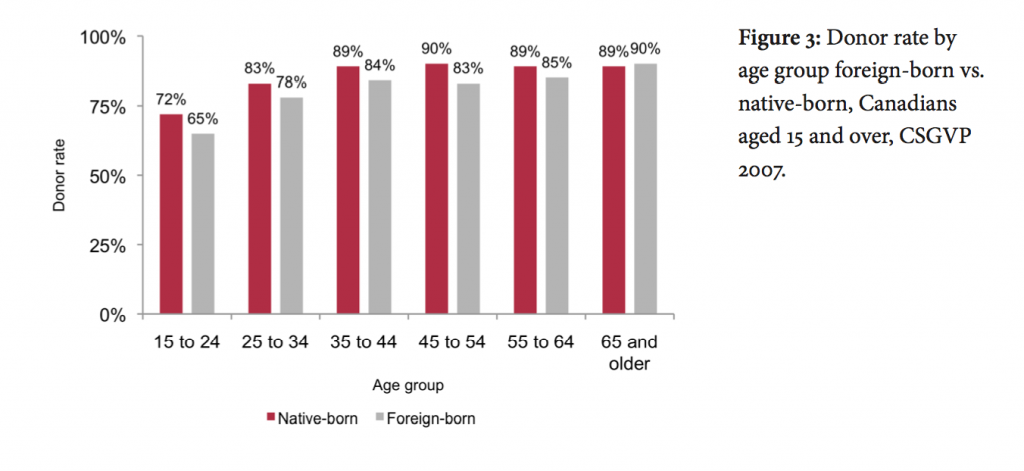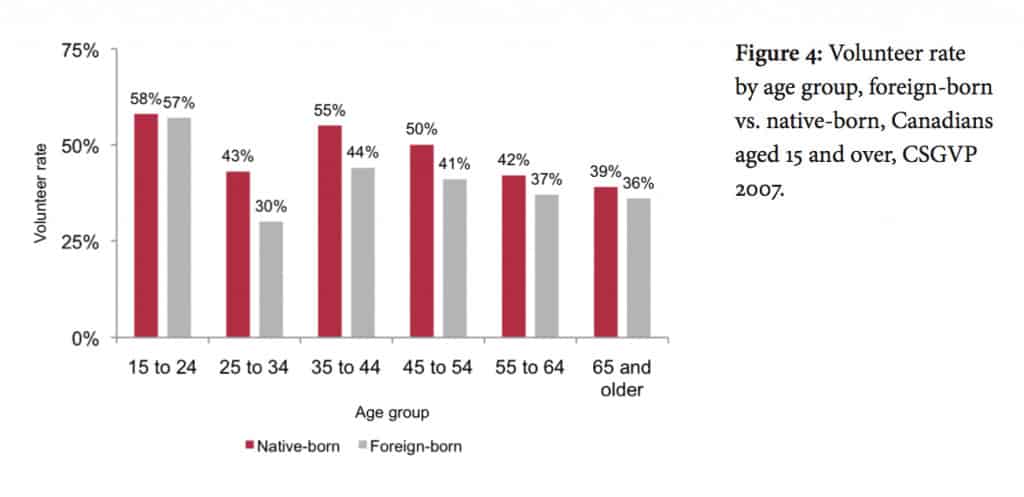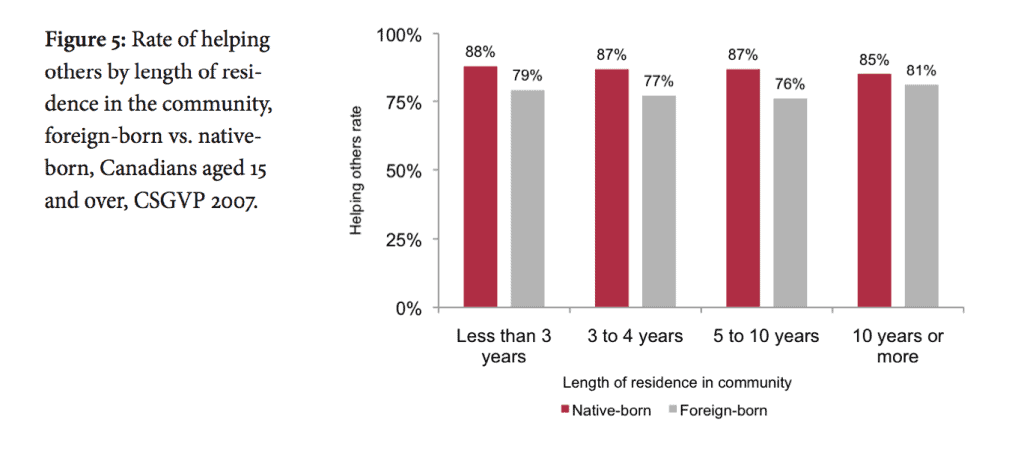Introduction
Individuals born outside Canada make up a significant proportion of the Canadian population. According to the 2006 Census, the foreign-born accounted for 19.8% of the total population of Canada (Chui, Tran, & Maheux, 2007). Fortunately for those interested in diaspora philanthropy, the 2007 Canada Survey of Giving, Volunteering, and Participating (CSGVP) provides significant insight into some of the key pro-social behaviours of this group.1
Levels of giving, volunteering, and helping others directly
The CSGVP asks respondents about their giving, volunteering, and helping others over the previous one-year period. It covers giving and volunteering to charitable and nonprofit organizations as well as providing help directly to others, without involving an organization (this is sometimes known as informal volunteering). Donors and volunteers are those who contributed at least one dollar or one volunteer hour to an organization over the previous year, while helpers are those who provided at least one episode of assistance to those living outside the household.
Both native-born and foreign-born Canadians were substantially more likely to donate or to help others directly than they were to volunteer for an organization (see Figure 1). In terms of comparisons between the two groups, foreign-born Canadians were roughly as likely as those born in Canada to donate but somewhat less likely to help others directly or to volunteer for an organization.
Figure 1: Levels of pro-social behaviour, foreign-born vs. native-born, Canadians aged 15 and over (CSGVP, 2007).
Inter—relations between forms of pro-social behaviour
One of the major findings of the CSGVP is the degree to which the various forms of prosocial behaviour are linked. Individuals who engage in any single pro-social activity are more likely to engage in all of the others (e.g., donors are more likely to help others and to volunteer than are non-donors). Indeed, solid majorities of both native-born and foreignborn populations engaged in two or more pro-social behaviours (see Figure 2).
Figure 2: Number of forms of prosocial behaviour engaged in, foreign-born vs. native-born, Canadians aged 15 and over, CSGVP 2007.
However, there are some important differences between the two groups. Firstly, driven largely by the reduced likelihood of volunteering, foreign-born Canadians were less likely to report engaging in all three pro-social behaviours. Secondly, there appears to be a more pronounced hierarchy of pro-social activities among the foreign-born. Foreign-born respondents who engaged in one activity were somewhat more likely to donate (53% did so) than they were to help others (42%; see Table 1).
In comparison, native-born Canadians who engaged in one form of activity were equally likely to donate (46%) or to help others (47%). Among those engaging in two activities, the patterns of involvement were virtually identical for both groups. Hence, among the foreign-born the hierarchy of pro-social behaviour appears to be ordered as donating, helping, and volunteering, while among the native-born, helping others and donating appear to be largely interchangeable.
The effects of age and length of residence in thecommunity
The differences between foreign-born and native-born Canadians in rates of engaging in pro-social behaviours appear very broadly to decrease with age. For instance, nearly three quarters (72%) of native-born vs. two-thirds (65%) of foreign-born Canadians aged 15 to 24 donated, compared to roughly nine-tenths of both groups (89% and 90% respectively) of those 65 and older (see Figure 3).
A somewhat similar pattern can be seen with volunteering and helping others, though with these two behaviours there are notable deviations from the pattern among those aged 15 to 24 in that, in this age bracket, both groups were roughly equally likely to volunteer and help others (for example, see Figure 4).
Differences between foreignand native-born groups also appear to generally decrease with length of residence in the community. For example, the difference in the rates of helping among those who had been resident in their community for 10 years or more was much smaller than the difference among those who had lived in the community for less than 3 years (see Figure 5).
Barriers faced by the foreign-born
Part of the reason for the reduced rate of volunteering among foreign-born Canadians is likely because they face higher barriers to volunteering. Foreign-born non-volunteers were more likely to report most barriers to volunteering, particularly not knowing how to become involved and the financial costs of volunteering (see Figure 6).
Conversely, the foreign-born were not more likely to report that they had no interest in volunteering. It is reasonable to suspect that the foreign-born may also be more susceptible to barriers to giving and helping others, though this must remain speculative because the CSGVP does not question non-donors and non-helpers about the barriers they face.
Summary and discussion
The data described above show that foreign-born Canadians and native-born Canadians differ in their propensity to give, volunteer, and help others, in the degree to which prosocial behaviours are linked and in their responsiveness to particular barriers. Further, the patterns in the data are consistent with a process of gradual assimilation wherein foreign-born Canadians gradually come to respond more like native-born Canadians. In themselves, these findings are not particularly surprising. However, two factors are particularly interesting: 1) the process of assimilation appears to be quite long-lasting (as shown by comparing the patterning in the age-based data with that of the length of residence in the community), and 2) the differences among youth (those aged 15 to 24) for volunteering and helping others are strikingly less than among older Canadians. One possible reason for the latter finding may be that there are both significant expectations and opportunities for youth to engage in pro-social behaviour (e.g., mandatory volunteering as a school requirement). Promising areas of future research would be to explore the linkages between social networks and pro-social behaviours among the foreign-born as compared to native-born Canadians and whether foreign-born Canadians who emigrated to Canada during or prior to the ages of 15 to 24 were more likely to engage in pro-social behaviours.
Note
1. Every three years the CSGVP surveys individual Canadians aged 15 and over about their giving, volunteering, and participating over the previous year. The survey is conducted by Statistics Canada and has two components: the CSGVP Main and the CSGVP North. Only responses from the CSGVP Main (20,510 Canadians in 2007) were incorporated in the Public-use Microdata File used to produce this analysis. For more information about the CSGVP, readers are referred to the Statistics Canada website: http://www.statcan.gc.ca/pub/71-542-x/71-542-x2009001-eng.htm .
Reference
Chui, T. Tran, K., & Maheux, H. (2007). Immigration in Canada: A portrait of the foreign-born population. Catalogue no. 97-557-XIE2006001. Ottawa, Ontario.
[Last updated: November 20, 2009.] http://www12.statcan.ca/census-recensement/ 2006/as-sa/97-557/p2-eng.cfm [April 18, 2011].
David Lasby is Director, Research, at Imagine Canada. Email:dlasby@imaginecanada. caæ
